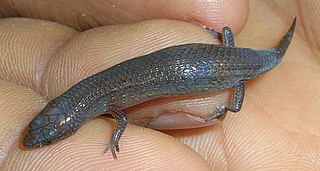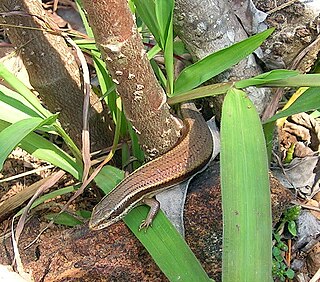
Skinks are lizards belonging to the family Scincidae, a family in the infraorder Scincomorpha. With more than 1,500 described species across 100 different taxonomic genera, the family Scincidae is one of the most diverse families of lizards. Skinks are characterized by their smaller legs in comparison to typical lizards and are found in different habitats except arctic and subarctic regions.

Cryptoblepharus is a genus of skinks, lizards in the family Scincidae. The genus contains at least 53 species.

Lampropholis is a genus of skinks, commonly known as sunskinks, in the lizard subfamily Eugongylinae of the family Scincidae. The genus Lampropholis was previously found to belong to a clade with the genera Niveoscincus, Leiolopisma and others of the Eugongylus group within Lygosominae. All species of Lampropholis are endemic to Australia. For similar skinks see genera Bassiana, Pseudemoia, and Niveoscincus.

Morethia, commonly called Morethia skinks or firetail skinks, is a genus of skinks in the order Squamata that are found in Australia.

Ristella is a genus of skinks, lizards in the family Scincidae. The genus is endemic to the Western Ghats of southwestern India. Member species are commonly known as cat skinks because of their retractile claws. This genus can be instantly identified by the presence of only four fingers in forelimbs in all the species. All the members look more or less similar, and are drab dark brown to blackish in colouration, with paler undersides. This poorly known group of lizards is diurnal, insectivorous, terrestrial to semi-fossorial in habits. They inhabit deep leaf-litter and grasslands in montane forests and rainforests.

Saproscincus is a genus of skinks native to Australia, sometimes referred to as shadeskinks. It contains the following species:

Blue-tongued skinks comprise the Australasian genus Tiliqua, which contains some of the largest members of the skink family (Scincidae). They are commonly called blue-tongued lizards or simply blue-tongues or blueys in Australia or panana in Indonesia. As suggested by these common names, a prominent characteristic of the genus is a large blue tongue that can be bared as bluff-warning to potential enemies. The type of predator/threat that is near will determine the intensity of colour present in the tongue. The tongue can also deform itself and produce a thick mucus in order to catch prey. They are relatively shy in comparison with other lizards, and also significantly slower due to their shorter legs.

Eurylepis taeniolata, the ribbon-sided skink, alpine Punjab skink, or yellow-bellied mole skink, is a species of skink found in Central Asia, South Asia, and West Asia. It is the type species of the genus Eurylepis.
The Lord Howe Island skink is a part of the native Australian reptiles’ classification. The Lord Howe Island Skink is a species of skink in the family Scincidae, located on Australia's Norfolk Island and Lord Howe Island. The Lord Howe Island skink population is uncommon to be found on Lord Howe island, however the majority of their population is located on the Norfolk Island complex.This skink is metallic bronze in colour and has flecks for defining features. It can grow up to 8cm in length, making them medium in size. Its taxonomy is diverse, the skink is a part of the Scincidae family, Oligosoma genus. This skink population is protected and considered vulnerable under the Environment Protection and biodiversity conservation act 1999.

Lygosominae is the largest subfamily of skinks in the family Scincidae. The subfamily can be divided into a number of genus groups. If the rarely used taxonomic rank of infrafamily is employed, the genus groups would be designated as such, but such a move would require a formal description according to the ICZN standards.

Eulamprus quoyii, more commonly known as the eastern water skink, eastern water-skink, or golden water skink, is a viviparous species of diurnal skink. Eulamprus quoyii belongs to the family Scincidae and is considered a common garden animal in Australia. The skink is endemic to Australia and found only along the east coast of the country. It makes its home in creekside habitats along the east coast of Australia and in urban garden areas with high amounts of moisture. The species can be identified by the twin, long yellow stripes that run along its body from the top of the eye, as well as by several more specific character derived states. The pale yellow dorsolateral stripes are most likely where its common name, the golden water skink, is derived. Like other ectotherms, the skink can often be seen basking in the sun on rocky outcroppings in order to regulate its body temperature. Its diet mainly consists of both aquatic and terrestrial insects, tadpoles and small amounts of plant matter. The skink both hunts for food and scavenges when necessary and is considered an opportunistic feeder. It is prey to larger lizards, snakes, cats and birds and so will often be seen moving quickly into hiding when other organisms are present.

Trachylepis capensis is a species of skink, a lizard in the family Scincidae. The species is native to southern Africa.

The Centralian blue-tongued skink or Centralian blue-tongue is a species of skink, occurring predominantly in the far north-west corner of New South Wales, Australia. It is one of six species belonging to the genus Tiliqua; the blue-tongued skinks and the shinglebacks. This species of reptile classifies as a lizard.
The Venezuelan mountain skink is a reptile, a member of the skink family, Scincidae. It is monotypic in the genus Orosaura.

Eugongylinae is a subfamily of skinks within the family Scincidae. The genera in this subfamily were previously found to belong the Eugongylus group in the large subfamily Lygosominae.

The desert egernia, unadorned desert-skink or desert skink is a species of skink, a lizard in the family Scincidae. The desert egernia is endemic to the continent of Australia, and is widespread, with populations recorded in all mainland states and territories except the Australian Capital Territory. The desert egernia is found in dry, desert areas with deep, uncompacted sandy/loamy soils and little significant vegetation cover.

The northern pale-hipped skink is a species of lizard in the family Scincidae. It is endemic to New Caledonia.

The pale-rumped ctenotus or regal striped skink is a medium-sized species of skink with an arid distribution restricted to the Australian Mainland, which belongs to the largest group of reptiles in Australia, Ctentotus.
The ghost skink is a species of skink endemic to Australia.















